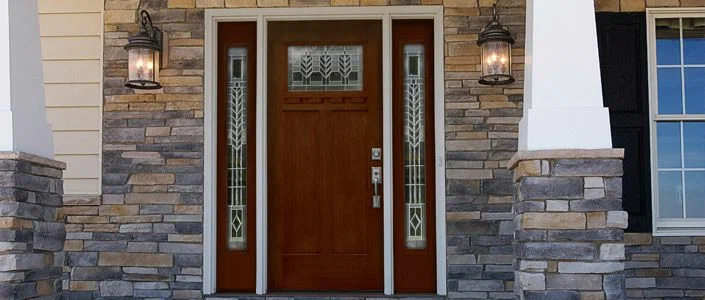How to Insulate a Drafty Front Door (And When It’s Time for a New One)
Do you feel cold air sneaking in from your front door, even when it’s closed? That’s a common issue, especially in older homes. A drafty front door can increase energy costs and reduce the comfort of your home.
Why Insulating Your Front Door Matters
Your front door is one of the biggest openings in your home. If it’s not sealed properly, it lets warm air out and cold air in—or the other way around, depending on the season. That forces your HVAC system to work harder, which means higher bills and more wear on your heating or cooling unit.
Insulating your front door helps:
- Keep your home comfortable all year round, warm in the winter and cool in the summer.
- Lower your energy costs
- Block out noise from the street
- Prevent dust, moisture, and insects from entering
It’s a small change that brings a big improvement in comfort and energy savings. But if these issues continue, front door replacement might be the smartest option.
How Can I Make My Door More Insulated?
If your front door feels drafty, don’t worry—you don’t always have to replace it right away. In many cases, you can seal up gaps and add insulation to fix the issue.
Here are a few easy ways to make your door better insulated:
- Install weather stripping around the sides and top of the door frame
- Add a door sweep to block air from coming in under the door
-
- Use a draft stopper or door snake for extra protection
- Check for loose hinges or an uneven frame and tighten or adjust them
These fixes are quick and affordable. You can do most of them yourself in less than an hour. But if the draft persists, front door replacement can be the long-term fix you need.
How to Insulate Doors: A Simple Step-by-Step Guide
Whether your door is made of wood, steel, or fiberglass, here’s how to insulate it:
- Check for drafts –Place your hand on the edges of the door.
- Clean the surface – Wipe the edges of the door and the frame with a damp cloth. This helps materials stick better.
- Apply weather stripping – Stick foam or rubber strips around the door frame.
- Install a door sweep –Place a sweep at the bottom of the door to close the gap on the floor.
- Seal any gaps or cracks – Use caulk or foam spray to close any open areas around the frame.
This method works for both interior and exterior doors, but it’s especially helpful for the front door since it faces the weather directly.
How to Insulate Your Exterior Doors
Exterior doors need stronger insulation because they’re exposed to wind, rain, and heat. If your door is older or made of thin wood, it may not have enough built-in insulation.
Here’s how to improve it:
- Use insulating door films or thermal curtains in colder months
- Add foam panels behind the door panels if there’s space
- Replace the threshold if it’s worn or damaged
- Look for signs of warping or cracking that let air through
If these issues are too severe or persistent, it might be time to consider front door replacement to restore proper sealing and security.
How to Insulate Interior Doors
Interior doors don’t need as much insulation unless you’re trying to block sound or control the temperature between rooms. If that’s your goal, try these options:
- Add foam strips or seals to the frame
- Use a door sweep on the bottom
- Hang heavy curtains or acoustic panels if noise is a concern
While not a priority for energy efficiency, these changes can help create quieter and more private spaces inside your home.
Best Materials for Door Insulation
Not all insulation materials are equal. Here are some of the best options for doors:
- Rubber or foam weather stripping – Flexible and easy to apply
- Vinyl or metal door sweeps – Long-lasting and effective
- Spray foam – Fills cracks and expands into tight areas
- Silicone caulk – Great for sealing frames and edges
- Insulated door cores – Found in newer steel and fiberglass doors
If your current door lacks insulation in its core, a full front door replacement may provide better results than temporary solutions.
Is It Time to Replace Your Doors?
Sometimes insulation isn’t enough. If your door is badly damaged, warped, or very old, a replacement may be the smarter move.
- The door feels loose, doesn’t close properly, or has large gaps
- It’s cracked, bent, or warped from weather exposure
- You’ve tried sealing it, but it’s still drafty
- You can see light around the edges
- Your home is still uncomfortable despite insulating
A new, energy-efficient front door replacement can solve all of these problems and improve your home’s look and security at the same time.
What if These Solutions Don’t Work?
Tried all the DIY options and still feel cold air coming through your door? If nothing seems to work, it might be time to talk to a professional.
That’s where All In One Home Repair & Remodeling can help. We can inspect your front door, recommend the best fix, and install a high-efficiency front door replacement if needed. A properly sealed, energy-smart front door makes a huge difference in comfort and cost.
Final Thoughts
A drafty front door is more than just a nuisance—it affects your home’s temperature, comfort, and energy use. Start with insulation steps like weather stripping and sweeps. If those don’t solve the problem, consider a front door replacement with a modern, insulated option that’s built to last.
Making this one upgrade could give your home a noticeable improvement for years to come.
FAQS about Door Replacement:
1. How can I tell if my front door needs to be replaced?
If your door is warped, cracked, or drafts persist after sealing, it’s time for a front door replacement.
2. Can insulating my front door really save me money on energy bills?
Yes! Proper insulation prevents energy loss, reducing the strain on your HVAC and lowering energy bills.
3. What are the best materials for insulating a front door?
Rubber weather stripping, vinyl door sweeps, and insulated fiberglass or steel doors are the best for insulation.
4. How do I know if my front door can be insulated, or if I need a replacement?
If sealing gaps doesn’t stop drafts or if the door is damaged, you likely need a front door replacement.
5. Can I insulate my front door myself, or should I hire a professional?
Basic insulation like weather stripping can be DIY, but for a full front door replacement, hire a professional for best results.




Leave a Reply
Want to join the discussion?Feel free to contribute!